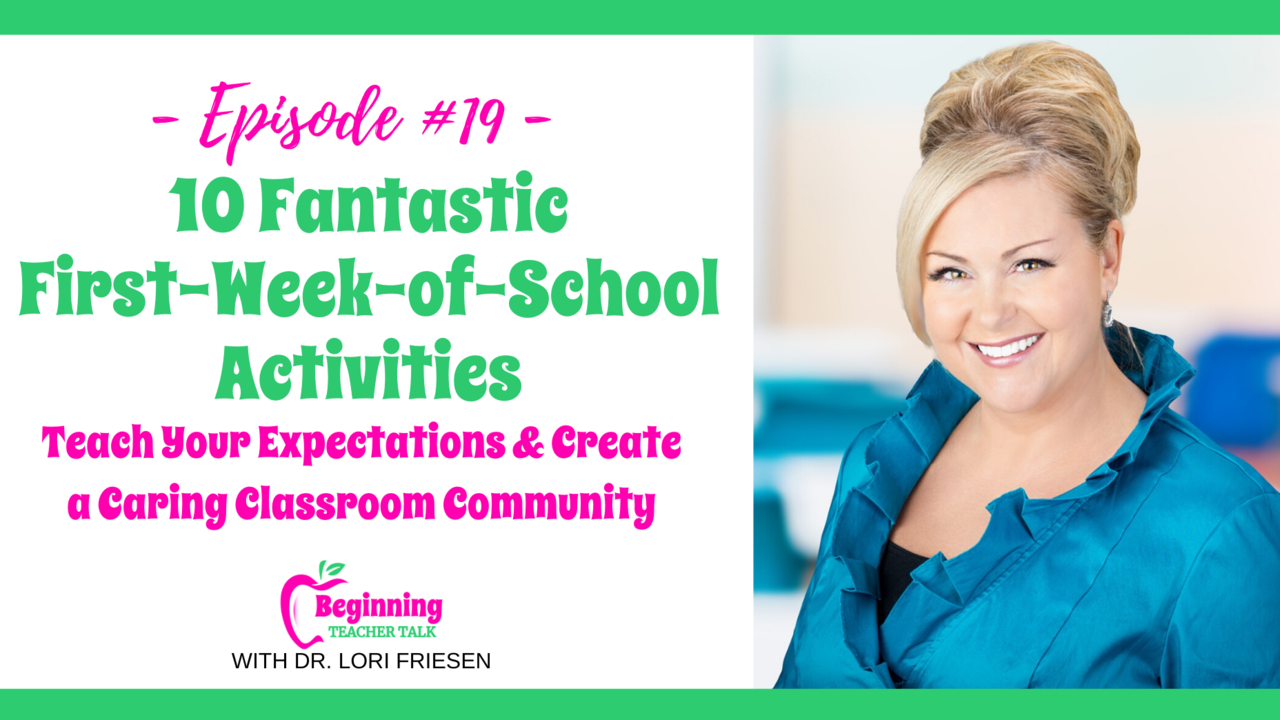10 Fantastic First Week of School Activities

Just click the "Play" button below to listen to this episode now:
Please Note: THE ORIGINAL FREEBIE FOR THIS EPISODE IS NO LONGER AVAILABLE, BUT HAS BEEN EXPANDED IN MY NEW PRODUCT ON TEACHERS PAY TEACHERS. HOWEVER, YOU CAN STILL GET THE DETAILS ON ALL OF THE ACTIVITIES MENTIONED IN THE PODCAST HERE. :-)
Show Notes:
We are going to have SO much fun this week!
I am probably a little bit of a geek with how excited I get about the first week of school.
The first week makes me feel like I am seven years old again, and I get all of the same butterflies and feelings of nervousness and excitement I've always had whenever I start something new. I think it's because the start of each school year represents a fresh start - an opportunity to do things better. 😊
Now last week, I gave you SO much information about how to teach your rules and routines within the larger context of your first week of school, so today I want to dive in deep about exactly what kinds of activities you might want to select to do with your students during those very important first few days as you are introducing and practicing your class routines with your students.
If you haven’t listened to Episode #17 and Episode #18, you may want to go back and listen to those shows before this one so that everything I am teaching you in this episode makes sense.
I want to start by saying that in all of my work with beginning teachers across the country, developing and consistently reinforcing class routines is always one of the biggest challenges for new teachers, and I think this is because many of the routines you will be teaching will be new for you as well.
This might sound kind of dumb to you, but I’ll never forget when that lightbulb moment happened for me – I knew I needed to teach my class expectations, and I knew I wanted to do some fun activities with my students, but it was pretty cool when I finally realized that I could put the two together – and it was a game changer for me.
Because teaching these routines is new for you as well, keeping routines top of mind will likely be difficult unless you are constantly reminding yourself to remind your students of what the expectations are in this classroom.
So, for each activity, I will remind you of some of the routines you will want to teach alongside each activity so you can begin to think about how you want to shape that first week in your classroom.
I tend to be really heavy with getting to know you activities during the first day and a half of school, and then I begin to layer in some actual curriculum content as I introduce what will be our daily and weekly schedule to my students as we move throughout our first week.
However, I do build in lots of opportunities for my students to get to know each other throughout the first week, even if we are beginning to launch into curriculum content.
Part of the reason I do this is because many of these activities not only help my students to begin to feel more comfortable and at home in this new space, but we also use a lot of their work to decorate our classroom so they can see a part of themselves and really develop a sense of belonging in this new space before we dive into more difficult content.
Child psychology and learning theory research indicate that children need to experience many small successes in order to feel safe and to be willing to take risks in an educational environment, and so the activities I am going to share with you are all designed to contribute to developing a sense of safety and cohesiveness among students.
Be sure to tune in next week when I do book talks featuring my favorite books for back to school, along with some of my favorite activities to do with them! To subscribe to this podcast so you never miss an episode, just click here.
I hope you have a wonderful week, and remember – just because you are a beginning teacher, there is no need for you to struggle like one. I believe in you, I know you can do this, and I’m here to help you, every step of the way.
❤️ Lori
 Dr. Lori Friesen | Beginning Teacher Mentor
Dr. Lori Friesen | Beginning Teacher Mentor
Creator of the R.E.A.D.Y. for School Academy, Dr. Lori Friesen has mentored thousands of beginning teachers across the country through her workshops and courses. Host of the popular podcast, Beginning Teacher Talk, and creator of the innovative literacy program for 1st and 2nd grade, Dogs Help Kids Read and Succeed, Dr. Lori is dedicated to serving educators and inspiring learners. Learn more at drlorifriesen.com and at howdogshelpkids.com.
Stay connected for surprise goodies & updates!
Join our mailing list to receive the latest news from our team. 💛💕 Your information will not be shared.











